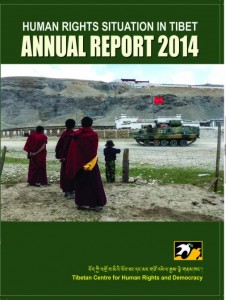 The Tibetan Centre for Human Rights and Democracy (TCHRD), a non-government organisation based in Dharamsala, released its 2014 annual report on the human rights situation in Tibet on February 7. Available in English, Tibetan, and, for the first time, Chinese, the report throws light on how the human rights situation continues to get worse by the day in Tibet despite reforms promised by the leadership in Beijing.
The Tibetan Centre for Human Rights and Democracy (TCHRD), a non-government organisation based in Dharamsala, released its 2014 annual report on the human rights situation in Tibet on February 7. Available in English, Tibetan, and, for the first time, Chinese, the report throws light on how the human rights situation continues to get worse by the day in Tibet despite reforms promised by the leadership in Beijing.
The report, released at the Library of Tibetan Works and Archives Hall in Gangchen Kyishong, highlights death in detention, collective punishment, and restrictions on the right to freedom of assembly and association, saying that the treatment of Tibetans has deteriorated substantially in these three areas.
Tibetan prisoners are frequently subject to torture, beatings, and denial of medical care. John Gaudette, Legal Research Officer of TCHRD, notes that an increasing number of Tibetans died because of their treatment in detention in 2014. One of the instances was the death of Tenzin Choedrak, who had every bone in his feet broken before he was returned to his family on the pretext of “medical parole” but died two days later.
A substantial improvement has been seen in 2014 in the maintaining of TCHRD’s Political Prisoner Database. A special team has made the database one of the most comprehensive Tibetan political prisoner databases in the world. It now includes information from various sources on 2,110 known political prisoners. This number includes the 137 Tibetans who were either detained or sentenced in 2014.
In 2014, 11 Tibetans set themselves on fire in Tibet, protesting against the People’s Republic of China’s (PRC) occupation of Tibet and its hard-line policies. Nine of them died as a result of the burns sustained during their protests. In keeping with this, the PRC has also expanded the scope of its punishment of Tibetans by announcing that entire families and villages would be punished if there was a self-immolation protest or if a person attended religious festivals. Tibetans who have protested against arbitrary arrests or illegal mining in Tibet have faced violent reprisals for exercising their right to freedom of assembly, several of whom can still not be traced.
With an examination of China’s 2010 census data, TCHRD has also found consistent and systemic problems with heath care and education in Tibet. The report undermines the PRC’s claims that it has improved life in Tibet finding that heath care in Tibetan areas is worse than almost anywhere else in the PRC. Similarly, it noted that Tibetans receive less schooling and that what they do receive is generally “ineffective and inefficient”.
The 206–page report also addresses violations of civil and political rights, including the right to privacy and the expansion of the security state; economic, social and cultural rights including the resettlement of the nomads; and the developments in the international community including
statements concerning the human rights situation in Tibet at the United Nations.
The Tibetan Centre for Human Rights and Democracy is a registered non-government human rights organisation established in 1996 in Dharamshala with the mission to protect the human rights of the Tibetan people in Tibet and to promote the principles of democracy in the exile Tibetan community. The Centre is entirely run and staffed by Tibetans in exile. The TCHRD logo features the image of a white dove rising out of flames. The dove and olive branch are universal emblems of peace. The flames, drawn in traditional Tibetan style, represent the suffering of the Tibetan people, as well as the devastating and purifying force of truth.




 Print
Print Email
Email